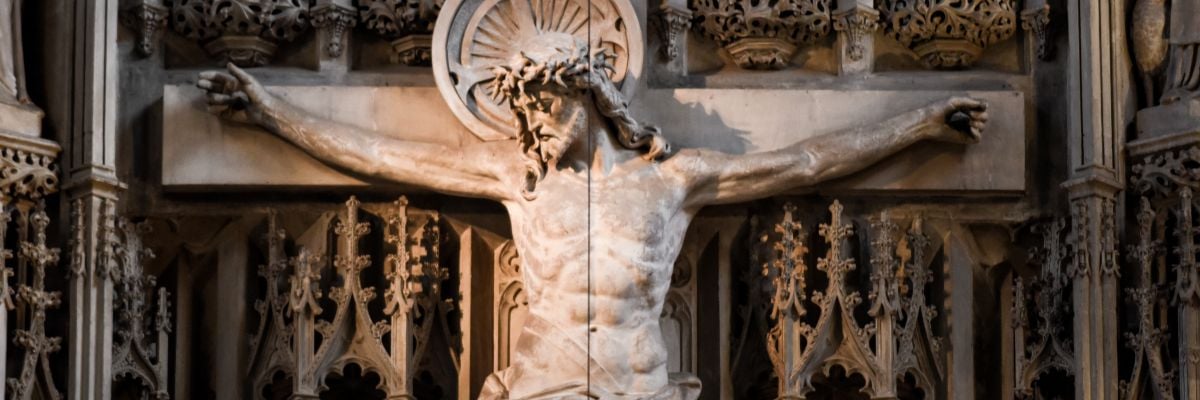
It’s one of those “facts” that we hear and read all of the time: Martin Luther began the Protestant Reformation in 1517 because the Church was in a state of severe moral and institutional decay and there was no hope of real reform.
In truth, the authentic renewal of the Church started long before the Protestant Reformation. In fact, a movement for renewal during the late Middle Ages—long before Luther was even born—laid the groundwork for the true reform of the Church in the sixteenth century. This Catholic Reform was part of a wider historical process of reform in the Church that deserves recognition and celebration.
The faithful across all of Christendom in the late Middle Ages—from the popes to the humblest serfs—were aware of the need for change and renewal in the Church. Many religious orders of the time were notorious for their failings and scandals, bishops and abbots were lampooned for being corrupt and blind to the problems faced by the Church, and to many, the Church’s leaders seemed too worldly and to be doing little to promote spirituality and the sacraments.
Grassroots efforts at reform were scattered across Christendom, but they lacked a single driving force to bring them all together. Still, what history suggests—and what is crucial for Catholics to know—is that there was widespread awareness of the need for reform in the Church before Luther, and a definite series of movements, or fronts, tried to bring it about. All of this was happening at the very time when most modern readers assume that the Church was at its lowest ebb.
Four of these fronts of reform are worth looking at closely: Christian humanism, spiritual renewal, the revitalization of the religious orders, and, finally, the efforts of a determined group of Church leaders who brought all the goals together under the rightful leadership of the papacy. These aspects of authentic Catholic reform not only prove the vitality of the late medieval Church but show that reform was truly on its way, even as Luther made his break with Rome.
Renewal from Within
Christian humanism, one of the forces for change, was a movement of rebirth that tried to be faithful to both classical and Christian traditions. It sought a revival in the study of ancient Greek and Roman literature, including the scholarly study of the scriptural and patristic sources for appreciating the faith. The humanists were Christian scholars who believed that the studia humanitatis (study of humanity) was the foundation of education and personal development and that the movement could usher in a new age for society.
The first humanists were openly contemptuous of the abuses in the Church and scornful of scholastic theology and philosophy. But from the middle of the fifteenth century, succeeding generations of humanists saw themselves as earnestly Christian. Desiderius Erasmus, John Colet, St. Thomas More, and others personally believed that Christian humanism offered a genuine means to revive Christian culture and life.
One of the foremost exemplars of this program was Francisco Ximénes de Cisneros, archbishop of Toledo from 1495 and a figure of immense influence at the court of Ferdinand and Isabella of Spain. Ximénes was determined to improve discipline among the clergy and regenerate the Church’s pastoral mission. His ambitious program (introduced at synods in Alcalá in 1497 and Talavera in 1498) stipulated norms of priestly conduct: His priests were to hear confession frequently, preach the gospel, and educate the young. In 1499, he laid plans for a new university at Alcalá, which from its inception was the center of humanism in Spain. In his pastoral and intellectual labors, Ximénes joined Renaissance humanism and Church revitalization, and Spain established itself at the forefront of the Catholic Reform.
Deeds Speak Louder Than Words
A broader movement toward renewed spirituality, the spiritual movement of the devotio moderna, appeared at this time. In 1501, Erasmus expressed the principles of a personal and deeply christocentric piety manifested in acts of charity and a moral life rather than in ceremonial or legalistic observances. The devotio moderna stressed personal prayer and meditation centered on Christ and the Gospels and the practice of the virtues. As Ignatius Loyola observed, “Love ought to manifest itself in deeds rather than in words.”
This late medieval Catholic spirituality was shaped by the older traditions of the Carthusians and Franciscans. The reformation of Catholic piety that followed the Council of Trent was deeply rooted in medieval devotion: The truth is that it showed a deep continuity with the past rather than a break from it.
One of the effects of spiritual reform was a renewal in sacramental life. The reformers all called for a return to the sacraments—the very thing that Luther’s doctrine of sola fide sought to undermine. They prescribed more frequent confession, more eucharistic devotion, and more frequent celebration of Mass for priests and bishops.
The laity’s response to these reforms was visible in the confraternities that flourished in Italy in the late fifteenth and early sixteenth centuries. The lay members of the Oratory of Divine Love in Genoa and Rome, for example, cultivated their spiritual lives through religious devotions and charitable works, in particular the care of the sick.
An “Ordered” Response
Renewal efforts were also evident in the emergence of new orders and in the transformation of the older ones. The community called the Theatines, which grew out of the Roman Oratory, was the first of the new orders. It was founded in 1524 by Gaetano dei Conti di Tiene and grew under its first active head, the future cardinal Gian Pietro Carafa. The order represented a permanent and organized expression of the Roman Oratory’s ideal: setting new standards for the priesthood and episcopate in Italy, revitalizing the Church’s pastoral mission, and employing the energized spirituality of the time by frequent communion and veneration of the Blessed Sacrament. Several other new orders followed, including the Regular Clerics of St. Paul, the Barnabites, and the Brothers Hospitallers of St. John of God.
Women also played a key role in the rebirth of religious life: Angela Merici founded the Ursulines, who were committed to service in hospitals, orphanages, and teaching. These women won approval from Pope Paul III in 1540, the year of Merici’s death. That same year, the pontiff promulgated the bull Regimini Militantis Ecclesiae, granting formal papal approval to the Society of Jesus. Begun by Ignatius Loyola, the Jesuits subsequently emerged as the vanguard of the Catholic Reformation.
Even as the new orders were flourishing, many established ones were reforming themselves by returning to stricter discipline, including the Dominicans in their so-called Dutch Congregation, the Camaldolese, and, above all, the Capuchin Franciscans. Begun by Matteo da Bascio in 1526, the Capuchins followed the fervor of their founder. They embraced strict fidelity to the ideals of St. Francis with stress placed on penance and prayer, preaching the gospel, and caring for the sick and poor.
This front of reform was assisted and encouraged by a party of determined reformers within the hierarchy of the Church. All of these bishops anticipated in different ways the reforms in clerical discipline, monastic life, and the spiritual needs of their flock that came out of the Council of Trent and forecast that active and dedicated popes and bishops were crucial to the Catholic Reformation.
Grassroots Renewal
The popes and the Curia, the central government of the Church in Rome, had been aware of the need for reform in the years before 1517, but the desire in Rome for change lacked firm resolve, as the Fifth Lateran Council’s feebly implemented reforms showed.
But a significant institutional reform party was centered in Venice and its vicinity. Its members included Carafa and other increasingly prominent Church figures such as Gasparo Contarini; Gian Matteo Giberti, the bishop of Verona; Gregorio Cortese, the abbot of the Benedictine monastery of San Giorgio Maggiore in Venice; and the young English noble in exile Reginald Pole. This group might have remained outside the halls of power in Rome if Alessandro Cardinal Farnese—dean of the college of cardinals and a charming, cultured, intelligent and hitherto worldly Renaissance prelate—had not been elected Pope Paul III in 1534.
Paul III was determined to convoke a general council and turned to the Venetian circle of reformers. He summoned Contarini to Rome in 1535 and made him a cardinal. At his urging, Paul III convoked a commission that included the Venetians and other like-minded reformers.
A varied group, its members all had demonstrated a commitment to reform. They all recognized the responsibility of the papacy, bishops, and priests in general for the calamities that had struck the Church. They also shared a vision of a reform program. Their work was presented to the Pope in March 1537. It was blunt in its criticism of the failings of the bishops, clergy, and religious and called for a more deliberate pursuit of the pastoral ideal. The committee believed that, above all, Rome had to serve the faithful as an example rather than a scandal, “the mother and teacher of the other churches.” The committee appealed to the pope to take action.
The disaster of the Lutheran schism in Germany swept away the final bars separating the streams of the reform movement, and their confluence was managed brilliantly through the genius and dedication of Pope Paul III and the leaders of the Church at the Council of Trent. Christian humanism, spiritual renewal, the new and renewed religious orders, and institutional reform were all apparent in the subsequent labors of the Tridentine Council. Above all, these earlier reform movements powerfully proved that the break from the Church by Luther and the Reformers who followed him was both unnecessary and actually behind the times of true renewal.



